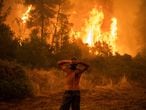With September also comes the hope of an autumn rain that ends one of the driest years it has seen in 126 recorded seasons, that is, since 1895. August is gone, but the warm temperatures remain in the region. 88% of the State suffers an extreme drought, which becomes exceptional in 47% of its surface, favoring the advance of large fires due to kilometers of dry vegetation. The Caldor fire has been ravaging Northern California for 23 days. Dixie, the largest, is still active in the same area, consuming 3,700 square kilometers (370,000 hectares) in 54 days, a larger area than Luxembourg. The rain usually put an end to these large-scale disasters. It was the help needed by the hundreds of crews of thousands of firefighters working to put them out.But that was before.
More information
The great scientific report on climate change blames humanity for the increase in extreme phenomena
The Oroville Dam, 128 kilometers north of Sacramento, the state capital, is at 22% capacity, its lowest level since 1968, the year it began operating.
The lack of rain has forced the abandonment of dozens of small summer boats in this popular reservoir for fishing and sports activities.
Other boats have been placed on wooden columns to prevent them from running aground at the dwindling level.
During the summer the drought left lonely images in California's second-largest man-made lake, which draws thousands of people each year to fish for bass and salmon.
At the beginning of August the level of the water reserve, which is 35% of the historical average, forced the authorities to stop the Edward Hyatt hydroelectric plant. The plant produces 1% of the average energy used daily in times of high demand, such as summer. This was the first time it was shut down since it began operating 53 years ago. The milestone is a worrying new precedent for an area that counts the season's rains with the fingers of one hand. Low reserves and high temperatures have forced the authorities to ask the 40 million Californians to reduce their energy consumption for five hours in the afternoons to ensure the smooth operation of the network. These extreme weather events, which are expected to increase with global warming,it has already strained the energy infrastructures of other US giants, such as Texas.
This is not an issue unique to Oroville. Of the 12 water reserves that California has, 9 are currently with a capacity of less than 40%. Among these is Lake Shasta, the largest in the state and an indispensable source of water for Sacramento and the central valley. It is at 26% of its capacity when its historical average for the period is 42%. The dock in the area has been moved 60 meters into the body to keep the boats running.
To find a worse situation you have to go back to 1976 and 1977, two of the driest years for California. Before the times of climate change began to break records, these were, respectively, the fourth and first driest year in a century of records (2021 is the second). Both had extremely low levels of rainfall, which put the State on alert, which at that time took 60% of its water resources from reserves on the surface. That critical situation was resolved almost by a miracle with intense rains that fell between January and March 1978. These allowed the reserves to be filled and prevented a third consecutive year of drought that “would have had catastrophic consequences in many areas”, according to a report from the epoch. The incredible recovery of 1978 even secured the supply for 1979.The report made an important warning: "The state's underground watersheds must be recharged to provide again the operating margins of 1977." Today, however, this advice has been ignored. Most farmers overexploit the mantles by drilling wells in search of water that they cannot find on the surface.
Providential rain had another stellar moment at the end of 2017, which earned a place in memory as one of the wettest winters in the history of the State. “So much melted snow came down from the Sierra Nevada mountains that it almost eliminated the Oroville Dam. The dam resists and the gates too. All the new water flows into the delta and what does not reach the sea fills the aqueducts again ”, describes journalist Mark Arax in
The Dreamt Land
, a chronicle of the battles of California and the booming momentum of agriculture in times of drought. The winter rains leave surpluses in the flows for the first time in six years.
Now it is not so clear that the miracle will come soon. Jelena Lukovic, a Serbian scientist, published research in early 2021 stating that the start of the California rainy season has been shifted 27 days, from November to December. And with the heaviest rains arriving in January and February. This is the conclusion of a team of scientists who experimented with climate models fed with variables from the last 60 years and found that the patterns of atmospheric circulation have changed. This means that the autumns will be drier, which represents a possibility that the wildfire season will lengthen. The scientists' finding requires California to take better care of increasingly scarce water.

